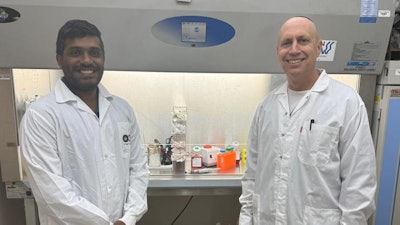
A new study from the Gray Faculty of Medical and Health Sciences at Tel Aviv University may mark a breakthrough in the treatment of Eosinophilic Esophagitis (EoE) — a chronic inflammatory disease of the esophagus caused by food allergies.
EoE leads to difficulty swallowing, chest and abdominal pain, and even growth delays in children. Its prevalence has been steadily increasing over the past decade in Israel and the Western world. In this new study, researchers identified the protein TSLP as a catalyst in the disease’s development, and found that neutralizing it may lead to significant relief of symptoms.
The study, led by Prof. Ariel Munitz and doctoral student Anish Dsilva from the Gray Faculty of Medical and Health Sciences, was conducted in collaboration with Dr. Chen Varol of Ichilov Hospital, Prof. Marc Rothenberg of Cincinnati Children’s Hospital, and the pharmaceutical company AstraZeneca. The research was supported by grants from the Israel Science Foundation, the US-Israel Binational Science Foundation, and the Azrieli Foundation Canada–Israel. The article was published in Allergy, the leading journal in clinical immunology.
Prof. Munitz explains: “Eosinophilic Esophagitis, or EoE, is a type of food allergy. It is a chronic inflammation of the esophagus caused by an abnormal immune response to food — mainly milk, eggs, wheat, nuts, fish, and more. The disease is characterized by an accumulation of eosinophils, a type of white blood cell that is not typically present in a healthy esophagus. EoE is often associated with other allergic conditions such as asthma and atopic dermatitis. It causes difficulty swallowing, food getting stuck in the esophagus, chest and abdominal pain, and growth delays in children. Current treatments require restrictive diets, and in severe cases, patients rely on essential amino acid formulas. Over the past decade, there has been a concerning rise in the prevalence of EoE worldwide, including in Israel. We are studying the disease in depth to understand the involvement of various immune system components in its progression. These components may serve as targets for future treatment for this disease, and for other allergic disorders as well.”
A previous study from Prof. Munitz’s lab, also published in Allergy, presented an experimental model that closely mimics the course and symptoms of EoE in humans. As a direct continuation of that study, the researchers now focused on a specific aspect of the disease, aiming to understand the role of epithelial cells. Prof. Munitz elaborates: “Epithelial cells form a protective outer layer that prevents foreign bodies from entering organs, including the digestive and respiratory systems. In allergic conditions, epithelial cells release various substances in response to encountering an allergen, and these substances trigger the chain of events that initiate the inflammatory process we experience as an allergy attack.”
The researchers found that epithelial cells in the esophagus of the EoE experimental model secreted high levels of two proteins: IL-33 and TSLP. They also discovered that the esophageal tissue in the mouse models contained a variety of immune cells that express receptors for both proteins. The fact that these two proteins are released in EoE, and that there are tissue cells with receptors that can respond to them, indicates that these are active proteins capable of causing the onset of the disease.
The researchers then sought to understand the division of roles between these two proteins in the disease: does each contribute differently, or do they act together? They believed that answering these questions would clarify the mechanisms that trigger EoE, and reveal which could be blocked as a treatment strategy. To this end, they used genetic engineering tools to create experimental models of the disease in which one of the proteins was absent.
The findings were unequivocal: the absence of the IL-33 protein did not significantly change the course of the disease. However, in the absence of TSLP, there was a significant improvement in EoE symptoms — to the point where the disease did not develop at all. Furthermore, a series of experiments in which the researchers neutralized TSLP with an antibody led to a significant reduction in symptoms. Further investigation using sequencing technologies and bioinformatic analyses revealed that TSLP functions as a key regulator of the disease. Based on these findings, the researchers concluded that the TSLP protein could serve as a target for new treatments for chronic esophageal inflammation (EoE).
Munitz concludes: “In this study, we found that the TSLP protein is a central player in EoE — a disease that causes significant suffering and is becoming increasingly prevalent worldwide. We know that pharmaceutical companies are currently developing a variety of antibodies targeting disease-causing proteins, under the broad category of biological therapies, including antibodies against TSLP. We believe these antibodies could serve as an effective treatment for EoE.”






















